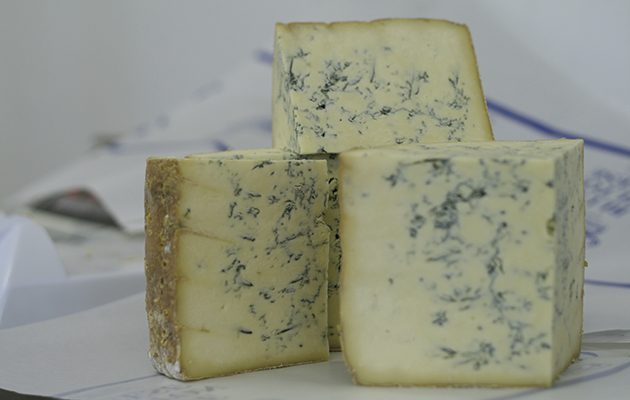Christmas Stilton is a festive essential, says Hattie Ellis. But despite its pride of place on our groaning boards, few of us know how to handle it to ensure mellow creaminess rather than dry strength
A Christmas cheeseboard is guaranteed to go down a treat. And there’s only one essential – the Christmas Stilton. But despite it’s popularity, it remains a misunderstood cheese. Read Hattie Ellis’ advice to enjoy mellow creaminess, rather than dry strength.
With Stilton on the board, the other festive essential is a gleaming Christmas ham. Read Christmas ham: cured for Christmas to learn how to prepare one at home – no vast pot required.
CHRISTMAS STILTON
Come Christmas, there’s one essential cheese for the table. Proud, strong and marbled with blue veins, it has to be the Christmas Stilton. Interestingly, this true blue gained its high status and popularity partly through hunting. From the mid-19th century, the new railways brought more city folk to hunt in the shires and acquire a taste for the cheese. The trains, in turn, sent wagon-loads of Stilton to Town.
There’s a further connection: the whey left over from production was fed to pigs. The pork from these pigs then went into another speciality favoured by hunt followers, Melton Mowbray pork pies.
It is now a tradition to have a large piece of Christmas Stilton to feed festive households, and six dairies make the cheese, all within the three counties of Derbyshire, Nottinghamshire and Leicestershire.
Cheesemakers use either plant- or animal-derived rennet to help the liquid milk coagulate into solid curds. In the past few decades, many makers have turned to plant rennet in order to make a vegetarian version.
However, a couple of makers, Colston Bassett and Cropwell Bishop, are in effect going “back-to-the-future” by returning to traditional animal rennet for some (but not all)
of their production. Billy Kevan of Colston Bassett believes animal rennet gives the cheese a deeper and more rounded flavour. He made the shift back 15 years ago, encouraged by Randolph Hodgson of Neal’s Yard, which sells the third of Colston Bassett’s output made this way.
Patricia Michelson of La Fromagerie in London is another cheesemonger who believes animal rennet gives a longer length of flavour. “There are loads of lovely minerals in Stilton, so you want the taste to go on and on,” she says.
HOW TO KEEP YOUR CHRISTMAS STILTON
Despite its fame, Stilton remains a slightly misunderstood cheese, not least in how it should be kept. Ben Skailes, of the family-run dairy Cropwell Bishop, explains how Stilton needs careful handling both by the producer and the consumer. This is especially true of how it is kept at home. “It looks old because of the crust and so people think they can keep Stilton a long time, but it does the cheese no favours,” he says. At best, you should try to eat your cheese within a couple of weeks.
If you get a half-Stilton or a whole baby cheese, you can wrap it in tea-towels and keep it in a cool room if you want the blueing to develop, as this is a “live” product. Patricia Michelson recommends turning the cheese every couple of days and making sure the crust isn’t too wet or too dry. What you are after is mellow and creamy, not strong and dry.
But though some tend their cheese in this way, the Stilton Cheese Makers’ Association recommends simply keeping it in the fridge. “Age doesn’t matter unless you’re a cheese,” as the saying goes and a cheese kept too warm for too long can mature too far.
At the table, instead of scooping into the cheese, cut around it (as though your knife were the big hand on a clock) to minimise the exposed area, covering the cut surface with
foil or cling film. The Association’s secretary, Nigel White, thinks quarter rings of Stilton are a good alternative to the traditional half-Stilton. These give the visual impact of the beautiful veining but are easier to handle.
THE DEFINITION OF STILTON
Stilton has been defined in some detail as far back as 1910. This means the style and name of the cheese have been protected. The rules defining a Stilton now include the need for the milk to be pasteurised. Some cheese-lovers, however, believe raw milk provides a great complexity and variation of flavours.
Randolph Hodgson and cheesemaker Joe Schneider set about making a cheese called Stichelton with organic, unpasteurised milk and the original Stilton recipe. Now in its tenth year, Stichelton is notably sweet and creamy and there is some variation between cheeses, both because it is a relatively new product that’s still settling down and because the milk varies daily. Joe Schneider thinks the best Sticheltons are made with autumn milk to be ready to eat in December. Indeed, this may be why this type of cheese came to be a Christmas treat in the first place.
Whether you prefer Stilton or Stichelton – or love them both, as I do – there’s often more than an ample sufficiency at Christmas-time, and many ways to use it. Patricia Michelson crumbles it over a refreshing bitter-leaf salad such as chicory with walnuts. Nigel White likes stirring it into a bowl of vegetable soup and using it in the classic turkey, Stilton and mango chutney sandwich. The Stilton website has 1001 further ways to finish off a big cheese.
As for what to drink with your Christmas Stilton, port is the classic – though sipped with, not poured on. The sweet-and-salty combination can also be found with Sauternes, porter or even whisky – a combination that certainly keeps out the January chill after the Christmas glow has faded.





